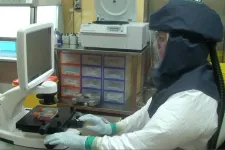(Press-News.org) IRS refers to the application of insecticide onto the interior walls of houses.
The study, by the Wits Research Institute for Malaria (WRIM) and the London School of Hygiene and Tropical Medicine (LSHTM), was published in The Lancet on 25 February 2021.
Targeted vs blanket Indoor Residual Spraying
Malaria still represents one of the world's largest health crises, particularly on the African continent where 94% of cases and deaths occur (World Health Organization, 2020).
Most countries in southern Africa have set the elimination of malaria within their borders as a policy target.
In South Africa, IRS has been effectively used since 1945. As a result, malaria transmission is low, but persistent. Malaria transmission is confined to the north-eastern border districts of Mpumalanga, Limpopo, and KwaZulu-Natal provinces.
IRS has been a highly effective strategy for controlling malaria in many countries. However, IRS is logistically challenging when deployed at scale and its costs are rising, due in part to the challenges posed in addressing resistance of malaria vector mosquitoes to low-cost insecticides.
Furthermore, it may be unwarranted and unsustainable to spray all houses in areas where malaria is rare (but not eliminated), particularly when resources are limited.
At a global level, spending on malaria prevention and treatment has remained stagnant for almost a decade, despite rising unit costs and growing populations. More efficient strategies are therefore urgently required to sustain malaria elimination efforts in low transmission settings.
"The increase in rural populations makes it very difficult to carry out IRS at the recommended coverage of 85% of all households before the malaria transmission season is in full swing," says Maureen Coetzee, Distinguished Professor in the WRIM and a co-author of the study.
"Reactive spraying and the substantial cost-saving make [targeted IRS] an effective strategy for the national and provincial malaria control programmes to adopt - based on good scientific data."
About the study
The study, titled Effectiveness and cost-effectiveness of reactive, targeted indoor residual spraying for malaria control in low-transmission settings: a cluster-randomised, non-inferiority trial in South Africa, was the first to investigate whether reactive, targeted IRS is non-inferior and more cost-effective compared with the standard practice of an annual mass spray campaign ahead of malaria season.
The trial was conducted in residential areas (clusters) in Bushbuckridge, Mpumalanga and in Phalaborwa, Limpopo province.
Clusters were randomly assigned to either the targeted or the standard approach. In the intervention arm of the trial, the teams only sprayed houses in response to a reported malaria case, and restricted spraying to just that house [the index case house] and up to eight neighbouring houses within 200m.
The targeted intervention therefore involved a substantial reduction in spraying, directed only at neighbourhoods where there had been recent evidence of malaria transmission as indicated by the occurrence of a recent malaria case.
Safe and cost-effective strategies
The findings proved that, within the pre-specified margin of 1 case per 1000 people per year, the targeted approach was no worse than the standard approach. Furthermore, the targeted approach proved highly cost-effective.
The average annual economic cost was $88 258 (±R1.2m, 2017 exchange rate) per 100,000 population for the targeted intervention, which is 52% less costly than the standard practice, which costs $184 319 (±R2.5m, 2017 exchange rate).
"The targeted intervention cost less because it involved spraying far fewer structures, did not use contract sprayers, and used substantially less insecticide, transport, and equipment," says Mr David Bath, Research Fellow in Health Economics at LSHTM and joint first author of the study with Dr Jackie Cook, Associate Professor in Malaria Epidemiology at LSHTM.
Targeted transmission solutions
The authors acknowledge that replacing an existing intervention, which has been standard practice for many years, would be politically and socially sensitive, and would require vigilance to avoid resurgence in cases. It is therefore important that strategies which reduce costs due to better targeting of IRS are based on robust evidence, as demonstrated by this study.
Mr Aaron Mabuza, co-chair of the South African Malaria Elimination Committee (SAMEC), co-author of the study and former manager of the Mpumalanga Provincial Malaria Control Programme, says: "I used to wonder whether there was an alternative to blanket IRS and this study on targeted IRS has addressed my question. The recommendations are realistic and implementable, and also tackle the problem of population increase, which now makes it nearly impossible for blanket IRS to be completed before high transmission starts."
Targeted IRS ensures the reallocation of saved resources to other life-saving malaria control and elimination activities, such as enhanced awareness campaigns, case management, surveillance, and epidemic preparedness
"The findings of the study represent an exciting development to divest funds into other areas contributing to malaria elimination in very low-transmission settings across southern Africa," says Coetzee.
INFORMATION:
Prior to the emergence of new mutants of the coronavirus, such as the British variant B.1.1.7, the SARS-CoV-2 variant named D614G had already mutated from the original SARS-CoV-2 pathogen that triggered the pandemic. D614G has rapidly spread to become the most abundant variant worldwide and this D614G mutation remains in all the new emerging variants. An international team including researchers from Bern has now been able to demonstrate in both the laboratory and in animal models why the D614G variant was able to gain the upper hand over the original SARS-CoV-2 virus. "Our approach ...
A study, led by researchers at the Instituto de Astrofísica de Canarias (IAC) and carried out with OSIRIS, an instrument on the Gran Telescopio Canarias (GTC), has found the most densely populated galaxy cluster in formation in the primitive universe. The researchers predict that this structure, which is at a distance of 12.5 billion light years from us, will have evolved becoming a cluster similar to that of Virgo, a neighbour of the Local Group of galaxies to which the Milky Way belongs. The study is published in the specialized journal Monthly Notices of the Royal Astronomical Society (MNRAS).
Clusters of galaxies are groups of galaxies which remain together because of the action of gravity. To understand the evolution of these "cities of galaxies" scientists look ...
Researchers from the Andalusian Centre for Molecular Biology and Regenerative Medicine (CABIMER), in collaboration with the Swiss Institute for Experimental Cancer Research (ISREC) have studied the mechanisms behind the higher tendency of people with Mulibrey syndrome to develop tumours. Their results point to the important role of the TRIM37 protein, whose absence explains the appearance of tumour cells.
Mulibrey syndrome is a so-called rare disease as it occurs in less than 5 out of every 10,000 inhabitants. Some of these diseases usually have a very definite genetic basis. ...
If light is strongly concentrated in time and space, resulting in extreme photon densities, it can enable interaction with all conceivable materials. By using these ultrashort laser foci, even transparent materials can be modified, even though they ordinarily would not interact. Short, focused laser pulses can overcome this transparency and allow energy to be deposited completely contact-free. The exact response of the material to the radiation can be very diverse, ranging from marginal refractive index changes to destructive microscale explosions that evacuate entire areas.
Using the laser pulses for optical machining allows for equally diverse material modification, such as separating or joining using the same laser system. Due to the extremely short exposure time and low degree ...
Based on a manual recently discovered in a 3,500-year-old medical papyrus, University of Copenhagen Egyptologist Sofie Schiødt has been able to help reconstruct the embalming process used to prepare ancient Egyptians for the afterlife. It is the oldest surviving manual on mummification yet discovered.
In ancient Egypt, embalming was considered a sacred art, and knowledge of the process was the preserve of very few individuals. Most secrets of the art were probably passed on orally from one embalmer to the other, Egyptologists believe, so written evidence is scarce; until recently, only two texts on mummification had been identified.
Egyptologists were therefore surprised to find a short manual on embalming in a medical text that is primarily concerned with ...
"Everyone's unique" is a popular maxim. All people are equal, but there are of course individual differences. This was no different with dinosaurs. A study by researchers at the University of Bonn and the Dinosaur Museum Frick in Switzerland has now revealed that the variability of Plateosaurus trossingensis was much greater than previously assumed. The paleontologists examined a total of 14 complete skulls of this species, eight of which they described for the first time. The results have now been published in the scientific journal "Acta Palaeontologica Polonica".
Plateosaurus lived during the Late Triassic, about 217 to 201 million years ago. "With well over 100 skeletons, some of them completely preserved, ...
The latest developments in fluorescence microscopy make it possible to image individual molecules in cells or molecular complexes with a spatial resolution of up to 20 nanometres. However, under certain circumstances, an effect occurs that falsifies the results: the laser light used can cause very reactive oxygen molecules to form in the sample. These can then damage the fluorescent dyes used to such an extent that they no longer fluoresce. Among microscopy experts, this effect is known as photobleaching.
However, various fluorescent dyes can also be transformed by photobleaching so that they absorb light of shorter wavelengths. "A previously red fluorescent dye then glows green. Its fluorescence ...
A study by researchers at William & Mary's Virginia Institute of Marine Science suggests that continued warming of Atlantic coastal waters may enhance the spread of invasive blue catfish within the Chesapeake Bay and other estuaries along the U.S. East Coast.
The research, by Drs. Vaskar Nepal and Mary Fabrizio of VIMS, appeared in a recent issue of PLOS ONE. It builds on an earlier study by the two authors showing that blue catfish can better tolerate salinity spikes than most freshwater fishes, and thus may be able to expand their range downstream into mainstem Chesapeake waters, and from there into new Bay tributaries and even Delaware Bay. "Blue cats" were introduced to tidal freshwater stretches of the James, York, and Rappahannock rivers during the 1970s and 1980s ...
Researchers at the Lady Davis Institute (LDI) at the Jewish General Hospital have discovered that increased levels of the protein OAS1 are associated with reduced mortality and less severe disease requiring ventilation among patients with COVID-19. Using drugs that boost OAS1 levels could be explored to try to improve these outcomes. The findings are published today in Nature Medicine.
"Our analysis shows evidence that OAS1 has a protective effect against COVID-19 susceptibility and severity," explains Dr. Brent Richards, a senior investigator at the LDI's Centre for Clinical Epidemiology and Professor of Medicine, Human Genetics, Epidemiology and Biostatistics at McGill University. "This is a very ...
A new study using leading edge technology has shed surprising light on the ancient habitat where some of the first dinosaurs roamed in the UK around 200 million years ago.
The research, led by the University of Bristol, examined hundreds of pieces of old and new data including historic literature vividly describing the landscape as a "landscape of limestone islands like the Florida Everglades" swept by storms powerful enough to "scatter pebbles, roll fragments of marl, break bones and teeth."
The evidence was carefully compiled and digitised so it could be used to generate for the first time ...







